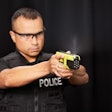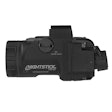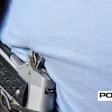If we learned anything from the North Hollywood Bank Robbery of 1997, besides the fact that law enforcement officers in this country possess uncommon courage, it's that we sometimes need the ability to "reach out and touch" our adversaries with superior firepower. This incident proved our handguns are no match against a fully automatic assault rifle in the hands of someone willing to use it.
As a result, new calls were heard to better arm law enforcement, calls that hadn't been heard since the days of Al Capone and other notorious criminals who armed themselves with the Tommy gun. To meet this modern-day challenge, many departments across the country opted to obtain patrol rifles for their officers.
Being able to "reach out and touch" someone at a greater distance, however, is not the only advantage of a patrol rifle. Its superior firepower, light weight, ease of use, dependability, and overall functionality make it a great weapon at close distances, as well. The problem is that most law enforcement patrol rifle training centers around skills, or tactics, designed for greater distances than are experienced in most street confrontations. Look at the case histories when these weapons have been used. Is the long distance shot sometimes being taken by officers? Yes, but the majority of the time the patrol rifle is deployed at much closer distances.
Necessary Skills
If you look at the circumstances surrounding the use of the patrol rifle by law enforcement, they are most often put into action at traffic stops, as in a high-risk stop, where the distance is not more than a car length or two ahead of the officer, or across a roadway. You'll also find that patrol officers and tactical teams most often deploy the rifle within a building, usually a residential building, where the distance is measured in a few feet, and not the hundreds of yards on a rifle range.
Even if you do find yourself at that long distance, can you make the shot? Are your skills where they need to be? When was the last time you fired your patrol rifle at that distance? Can you tell, with the naked eye, if the subject still poses a threat at 300 yards, 200 yards, or even 100 yards, in low light? More importantly, do you have a safe backstop to make that long distance shot? Remember, we are accountable for every round we send downrange.
Whether you're shooting your rifle a short or long distance, you need to be able to place the shot as safely and effectively as possible.
[PAGEBREAK]Good Tactics
In a recent case, a subject armed with an assault rifle opened up a barrage of gunfire on a New York State Police officer at a traffic stop near Albany. The trooper was able to retreat to a safe location with the help of a retired officer who just happened to be driving by. Other officers responded to the scene and hunkered down more than 400 yards away while the subject continued to fire wildly. At that distance the backup officers, from a 22-man police force which at the time only owned one patrol rifle for the entire department, felt that the distance was too great and lacked a safe backstop.
Two of these patrol officers, along with their chief, flanked the gunman's position to a wooded area on the side of the highway where they had a safe backstop, and quickly ended the confrontation with five well-placed shots. This department not only had the foresight to see the need for a patrol rifle, but after this incident the agency was able to find the funding to purchase two additional rifles.
On the other hand, the New York State Police still do not have patrol rifles in all of their vehicles and only carry buckshot in their shotguns, which they found out is not very effective at 400 yards.
Change Range Training
The shotgun is a devastating tool at close distances, but the patrol rifle is just as deadly given the right training. Therein lies the problem. We focus too much on that long distance shot, and not the close distances where we find the patrol rifle most often deployed. Is there a need to know how to make a head shot at 100 yards? Considering the human head can move four inches in one-sixtieth of a second, is it even possible? Should we spend our limited training resources on a shot that may not ever happen, or that is close to impossible to make in the field?
The answer is yes, because those shots do sometimes happen and we need to be prepared for them. The New York incident was terminated at a distance of roughly 70 yards. But we also need to be prepared and train for the close quarters shot where the rifle is most often deployed.
This is where some firearms instructors will advise you, "If they can hit the target at 100 yards, then they can hit it up close." But that's just not true. The dynamics of a gunfight at 100 yards are totally different from a gunfight occurring at five yards, 10 yards, or even 20 yards.
At 100 yards, we look for precision. At close distances, depending on the circumstances, we look for quick hits on the target. When that gunman pops out of a bedroom at the end of the hallway, we need speed and hits to end the fight quickly. When that driver exits his vehicle at a high-risk traffic stop with his gun blazing, we need to end the fight quickly.
Ending the fight quickly means placing effective rounds into your adversary as quickly as you can. This is actually very easy to do if you're willing to think outside of the box. The "box" I'm referring to is that square range you go to with your patrol rifle to qualify. We need to do more than just "qualify" on the range with the patrol rifle. A lot of time and effort went into the research, development, design, and manufacture of this weapon. Yet very few officers are aware of its true capabilities as a close-quarters tool.
[PAGEBREAK]Close-Quarters Capabilities
To understand the weapon's true capabilities in close quarters, you need to temporarily remove any fancy sighting systems from the firearm. Dot this, laser that, halo whatever; get rid of all of them. The iron sights the rifle came with are just fine. If you've found that a scope is beneficial-perhaps because you live in a sparsely populated area-great. But if you're like most of us, you're not going to have the room or the backstop to justify its limited use, or spending the money on scopes for all of your patrol rifles.
In close quarters, you don't even need your sights. At 25 yards and closer, you can easily place quick and effective rounds into the center mass area of a target. In my CQB Patrol Rifle class, the students routinely place quick, effective rounds into an eight-inch paper plate, and they do that while shooting and moving.
Think about this for just a second. When you're going down that hallway, clearing the building, looking for the bad guy, are you looking at your rifle, or are you looking down the hallway in case the bad guy jumps out at you? At that high-risk traffic stop, are you looking through the sights of your rifle with one eye closed, or are both of your eyes open in case someone in the car decides that he'd rather go down fighting than go back to jail?
In both cases, both of your eyes will be open. If you close one eye to get some type of traditional sight picture-with whatever sighting system you use-you limit your field of view.
To illustrate this, take your safe and empty patrol rifle and bring it up to your shoulder in the "traditional manner" that most of us have been taught. Get that "perfect cheek weld" to the buttstock of the firearm, and close one eye to align your sights. Keeping your eye closed and looking straight ahead, determine the parameters of your peripheral view. In layman's terms, how much of the surrounding area can you see without moving your eye?
Now bring the rifle's buttstock up to your shoulder, but this time don't "weld" your cheek to the buttstock. Keep your head square, and lower your chin. Lowering your chin is something we do naturally and instinctively under stress, so why not train that way? Keep both of your eyes open and look forward, as if you were looking down that hallway for the bad guy to pop out.
Also, square your body straight ahead to the target area. We don't blade our bodies under stress, and who clears a hallway in a building with their body bladed anyway? You'll notice that when you square your body, the end of the rifle's barrel will naturally align with the centerline of your body, so wherever you turn, or pivot to, your rifle will automatically point straight ahead on target. Now check out your peripheral vision. Has it greatly improved? Does it seem more natural, and realistic, to you?
Developing Realistic Training
That's what this is all about, to train the way we fight. When some departments made the switch from shotguns to patrol rifles, they followed the same reasoning they used for their shotgun training, and that was to do very limited training. When asked, one department stated their rifle training mirrored their shotgun training, five rounds once a year.
Other departments are a little more progressive, but most don't require their officers to shoot while moving. One department stated that if their officers don't "plant their feet" before firing, they are reprimanded on the range. Considering the dynamics of an actual shooting, that really doesn't make a whole lot of sense. Most officer-involved shootings, even with a patrol rifle, involve both of the parties moving. If that's the case, then again we need to train the way we fight.
When developing a patrol rifle training program, or for that matter any firearms training program, our training needs to reflect what actually occurs out on the street in the real world. We need to think outside of the box of that square range. If we move during a shooting incident, then we must train our officers to shoot while moving. If we deploy the patrol rifle in close quarters situations inside of a building, then we must teach sternum shooting and other close-quarter tactics. If we deploy the patrol rifle at traffic stops, then we must teach officers how to shoot in and around their vehicles, even through their vehicles. If we want officers to use cover as much as possible, then we must teach them how to use cover effectively when deploying the patrol rifle.
Should we train for that 100-yard shot? Yes, because it is realistic. But it is just as important to train for the close quarters situations where the patrol rifle is most often deployed. That 300-yard shot is nice to make on the range, but it isn't likely to be used in real life. So keep it real and train the way you fight.
Michael T. Rayburn has more than 30 years of experience in law enforcement and is the author of four books. He is an adjunct instructor for Smith & Wesson and is the owner of Rayburn Law Enforcement Training. He can be reached via editor@PoliceMag.com.

















